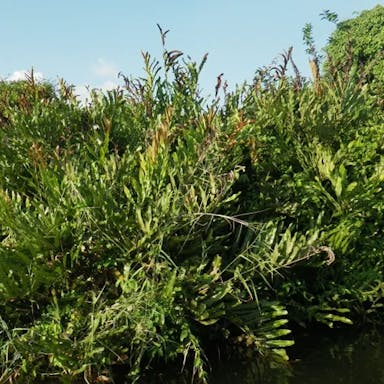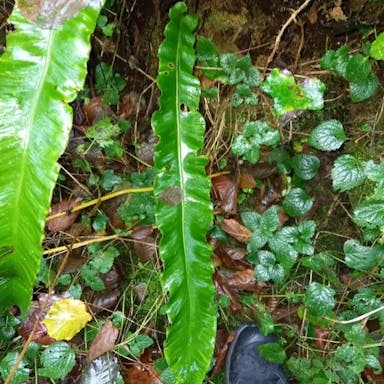Hart's-tongue fern, scientifically Asplenium scolopendrium, perennial plant in Aspleniaceae family. Native Europe, found woodlands, rocky slopes, limestone cliffs. Characterized long, strap-shaped fronds grow rosette pattern from short, creeping rhizome. Fronds glossy, leathery, undulating edges resemble shape hart's tongue, hence common name. Does not produce flowers fruits. Reproduces through spores undersides fronds. Spores typically brown color, released into air when mature. Known ability tolerate shade, thrive moist dry conditions. Considered easy plant grow, popular choice gardens, landscaping. In terms symbolism, associated resilience, adaptability. Ability survive various environments reflects strength, endurance. Additionally, unique appearance, vibrant green color make attractive ornamental plant. No known varieties Asplenium scolopendrium, other species Asplenium genus exhibit similar characteristics.
Hart's-tongue fern
- Scientific name
- Asplenium scolopendrium
Basic Information
- Aspleniaceae Family Asplenium Genus Hart's-tongue fern Species
- Aspleniaceae > Asplenium > Asplenium scolopendrium
- 83%
- The Completeness of This Encyclopedia
Please help us complete the encyclopedia, Terrarium is a encyclopedia service to be completed with everyone in the world. Currently, this page is 83% complete. For more information on how to contribute, please click here.
- Pteridophyta
- Height
- 50cm ~
- Flower Color
- Leaf Color
- Anthesis
- Sunlight Exposure
Full Sun Long hours of sunlight from morning to afternoon Partial Shade A location in the shade of a tree or where either the morning or afternoon is shaded Full Shade A place where there is no direct sunlight
- Partial Shade
- Hardiness Zones
This is an indicator to know to which zone each plant can winter. Knowing the zone of each plant gives you an idea of the cold temperature resistance when grown in the ground without a roof. 2: -42.7 to -40.0 3: -39.9 to -34.4 4: -34.3 to -28.9 5: -28.8 to -23.3 6: -23.2 to -17.8 7: -17.7 to -12.2 8: -12.1 to -6.7 9: -6.6 to -1.1 10: -1.0 to 4.4 11: 4.5 to 10.0
- 5
- Cold resistance
- Good
- Heat resistance
- Fair
- Habitat of origin
- Europe
- Growth Rate
- Normal
What is Hart's-tongue fern (Asplenium scolopendrium)?
What is Hart's-tongue fern (Asplenium scolopendrium)
Flower meaning
The flower language commonly associated with Hart's-tongue fern in America is sincerity. This plant is often used to convey heartfelt emotions and genuine purposes. In the language of greenery, each plant has a particular symbolism or feeling connected to it. Hart's-tongue fern embodies truthfulness. This shows that when someone gives or gets this fern, it represents their genuineness and authenticity in their deeds and expressions. It is a wonderful manner to communicate genuine emotions and feelings to another.
Calendar of Hart's-tongue fern (Asplenium scolopendrium)
Calendar
Hart's-tongue fern (Asplenium scolopendrium) is a perennial fern species native to the United States. The fern is perennial. Since it is not a flowering plant, it does not have a blooming period. Instead, it has green fronds all year. For health, give it shade and moisture. Drain the soil.
How to grow Hart's-tongue fern (Asplenium scolopendrium)
Watering
Hart's-tongue fern, scientifically known as Asplenium scolopendrium. This requires watering to thrive. Overwatering can lead to root rot. During spring to early autumn, keep soil evenly moist by watering deeply once or twice a week. Allow soil to dry slightly between waterings to prevent waterlogging. In winter, water every 2-3 weeks as the plant needs less moisture when dormant. Monitor soil humidity and adjust watering for optimal growth.
Soil and Fertilizer
Hart's-tongue fern, scientifically known as Asplenium scolopendrium, thrives in best soil conditions and needs certain fertilizers for healthy growth. This fern likes well-drained soil with a slightly acidic to neutral pH level ranging from 5.5 to 7.0. It is important to ensure that the soil is rich in organic matter and has good moisture keeping abilities. To give the necessary nutrients, a balanced fertilizer with equal amounts of nitrogen (N), phosphorus (P), and potassium (K) is suggested. The use of fertilizer should be done in early spring and late summer, as these are the times of active growth for the fern. The amount of fertilizer to be used depends on the size of the fern and the quality of the soil. Generally, a slow-release granular fertilizer can be used, following the maker's instructions for the right dosage. It is wise to avoid over-fertilization, as this can lead to nutrient imbalances and harm the fern. Regular checking of the soil pH and quality is key to ensure the best growth of Hart's-tongue fern. Changes to the pH level can be made by adding lime to raise the pH or sulfur to lower it, if needed. Additionally, maintaining proper soil moisture levels and providing good drainage are important for the fern's overall health.
Sunlight and Place
Hart's-tongue fern, Asplenium scolopendrium, prefers shady spots. This plant is not well-suited for bright light, as it can harm leaves. This fern moderately tolerates coldness, but has low heat endurance. Best temperatures for Hart's-tongue fern range from 50 to 70 degrees Fahrenheit. During summer, give this plant adequate wetness and humidity to avoid dryness. In winter, keep it in a cool area above freezing. Regarding placement, Hart's-tongue fern grows best in shade, like under trees or facing north. It tolerates brief morning or late light, but avoid direct midday brightness. Overall, this fern wants moderate sunlight, ideally getting 2 to 4 hours of indirect light daily.
Advanced Information of Hart's-tongue fern (Asplenium scolopendrium)
Pruning
Hart's-tongue fern, also known as Asplenium scolopendrium, does not require regular pruning or cutting back. This slowly growing plant remains attractive without much help. However, damaged or sick parts can be removed in early spring before new growth starts. Use clean, sharp pruners to cut off bad parts at the base. Take away fallen debris after pruning so problems don't spread. Proper care like watering and light keeps the fern healthy and looking good.
Planting and Harvest
Hart's-tongue fern, scientifically known as Asplenium scolopendrium, is a perennial fern that can be potted or planted in the ground. When potting this fern, drainage status of the container becomes a priority, as waterlogging shall be avoided using well-drained potting mix. Leave space for roots while placing the fern in pot gently and ensure crown is at soil level. Complete potting by pressing mix lightly and water thoroughly, keeping the plant in indirect sunlight. If repotting happens in spring, loosening roots gently while shifting the fern to a larger pot with fresh mix is advisable. Routine watering post repotting continues care process. Improper care causes fern decline. Overwatering can lead to root rot so direct sunlight exposure needs avoidance as it prefers shade or indirect light. Regular pest inspection and control measures for aphids, scale insects proves beneficial. Damaged frond pruning maintains appearance. With diligent care, potted or in-ground Hart's-tongue ferns thrive.
Propagation
In tropical countries, the tribal population uses the ferns in traditional medicine. A fern called Hart's-tongue fern develops by spreading spores, and is separated into new ferns, and also expands by cutting pieces of the underground stem. Growers collect spores by lightly shaking ripe fronds with spores into a paper bag. They spread the spores onto a tray of wet organic material. They cover the tray to keep the humidity, and put it in a bright warm spot. After some weeks, the spores will become little ferns. To propagate by separation, growers carefully divide the underground stems and plant each part in its own pot with soil that drains well. They keep the soil moist and put the pots in a shaded area. Pieces of the underground stem can also be propagated by cutting a section and planting it in a moist soil pot. Keep the soil wet until new growth starts. Harvesting is not required for propagation.
Pests and Diseases
Hart's-tongue fern (Asplenium scolopendrium) requires several pests and diseases. One common pest that affects this plant is the fern scale (Pinnaspis aspidistrae). These small insects attach themselves to the fronds of the fern and feed on its sap, causing yellowing and withering of the leaves. Regular inspection of the plant helps prevent infestation, and if scales are detected, they can be manually removed or treated with insecticidal soap. Another pest, the slug (Arion spp.), can affect Hart's-tongue fern. Slugs feed on the fronds, leaving behind irregular holes and causing damage to the plant. Creating barriers such as copper tape around the fern is effective to prevent slug infestation, as slugs are deterred by the electrical charge produced when they come into contact with copper. Hart's-tongue fern can be susceptible to fungal infections such as leaf spot (Cercospora spp.) and rust (Puccinia spp.). Leaf spot appears as small, dark spots on the fronds, while rust causes orange or brown pustules to form. Proper air circulation around the plant, avoiding overhead watering, and removing infected fronds promptly helps prevent these diseases. Withering of Hart's-tongue fern can also result from environmental factors such as excessive sunlight or drought. Providing the fern with adequate shade and regular watering can help prevent withering. Additionally, maintaining proper soil moisture and humidity levels contributes to the overall health of the plant and reduces the risk of withering.
Habitat of Hart's-tongue fern (Asplenium scolopendrium)
Habitat
Toxicity of Hart's-tongue fern (Asplenium scolopendrium)
Health Benefits
- edible
- Inedible
- Toxic
- No toxicity
NO DATA
Toxic for dogs and cats
NO DATA
Q&A of Hart's-tongue fern (Asplenium scolopendrium)
- Is there a recommended way to choose Hart's-tongue fern?
Hart's-tongue fern, scientifically known as Asplenium scolopendrium, is a popular fern species that can be grown from seedlings or seeds. When selecting seedlings, choose ones that have healthy, green fronds without any signs of discoloration or damage. The upright fronds well-formed, indicating a excellent plant. Avoid seedlings with weak or yellowing fronds, as these may mean poor health or illness. When selecting seeds, appearance for new seeds that are plump and firm. Avoid seeds that are discolored, as these may be damaged. It is also vital to choose seeds from a reputable company to guarantee their quality and capability to grow. Hart's-tongue fern has many types, each with its own distinctive features. The 'Cristatum' variety has fronds that are deeply crested, giving them a wavy look. The 'Angustifolium' variety has slimmer fronds compared to the typical variety, while the 'Marginatum' variety has fronds with unique white margins. Consider the details of each variety and choose the one that matches your preferences and growing requirements best. Overall, selecting seedlings or seeds carefully and considering the traits of different varieties will lead to successful growth of Hart's-tongue fern.











